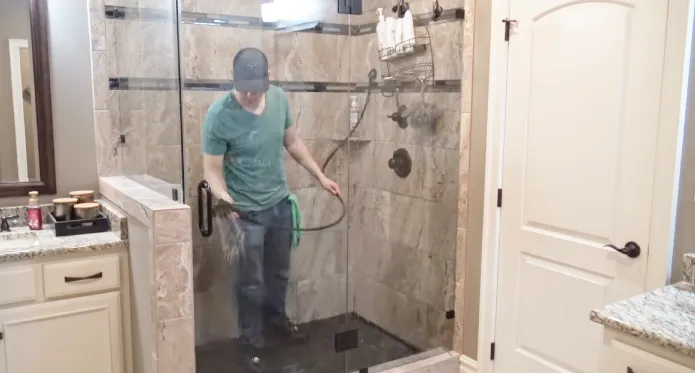Last Updated on November 14, 2023
Keeping your treated glass shower doors sparkling can seem daunting, but with the right materials and techniques, it doesn’t have to be hard work. Taking just a bit of time to prepare your door will ensure its beauty endures through every season.
Choose an effective cleaning solution or paste appropriate for the type of treatment on your door. Use protective gear when scrubbing or polishing the surface with a brush or sponge, so you don’t accidentally damage it while cleaning.
We’ll provide in a more detailed structured way on how to clean treated glass shower doors, including what materials and tools are needed, necessary preparation steps, the various techniques for cleaning the door, and how to establish regular maintenance practices to minimize future cleaning efforts.
How to Clean Treated Glass Shower Doors: 4 DIY Steps
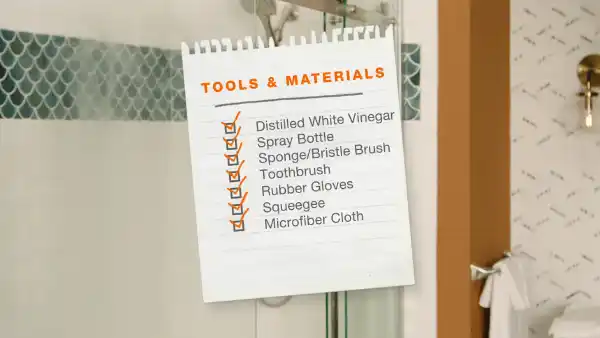
Step 01. Gather Materials and Tools Needed
Cleaning Solutions and Equipment
Here is a list of cleaning solutions and equipment that you can use to clean treated glass shower doors:
Cleaning Solutions:
- White vinegar
- Lemon juice
- Liquid dish soap
- Glass cleaner
- Baking soda
- CLR, or calcium lime rust remover
- Hydrogen peroxide
Equipment:
- Squeegee
- Magic Eraser or sponge
- Bucket or spray bottle
- Microfiber cloth or non-abrasive paper towels
- Protective gloves
- Mask or respirator (if using strong chemical cleaners)
Some of the cleaning solutions and equipment listed above may only be suitable for some types of treated glass. Always check the manufacturer’s instructions or consult a professional before using any cleaning solution or equipment on your shower doors.

Depending on the type of stains and dirt you try to remove, you may only need some of the solutions and equipment listed above.
Also, you should choose the cleaning solution based on the type of stains. Some solutions might be more suitable for water stains, while others for soap scum. It’s always better to start with a mild solution and move to a stronger one if needed.
Protective Gear
Always read the label and instructions on the cleaning solution, and follow the recommended safety precautions. Before using any cleaning solution, test it on a small, inconspicuous area first to ensure it won’t damage your shower door or cause any other issues.
And if you use any solution with strong chemicals or acids, you should ensure proper ventilation and follow the OSHA regulations. When cleaning treated glass shower doors, protect yourself by wearing the following protective gear:
- Gloves: Wearing gloves can help to protect your skin from coming into contact with cleaning solutions, which can be harsh and potentially damaging.
- Mask or respirator: If you’re using cleaning solutions containing strong chemicals, wear a mask or respirator to protect your lungs from inhaling any harmful fumes.
- Safety glasses: Wear safety glasses to protect your eyes from any splashes of cleaning solutions.
- Apron: Wearing an apron can help to protect your clothing from getting stained or damaged by cleaning solutions.
- Closed-toe shoes: Always wear closed-toe shoes to protect your feet from any splashes or spills.
Step 02. Prepare the Shower
Remove the Shower Curtain and Accessories
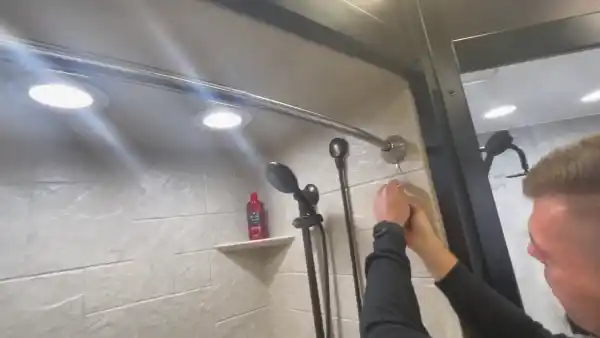
Using these steps, remove all shower curtains, liners, hooks, and accessories, so that you can give them proper cleaning and have a clear and clean surface to work.
Shower accessories can be disinfected and cleaned properly to prevent mold growth. The following steps will guide you through the process of removing shower curtains and accessories before cleaning treated glass shower doors:
- Remove the shower curtain: Take it down by carefully pulling it down from the hooks or rings. If your shower curtain has a liner, remove that as well. Fold them up neatly, or place them in a laundry bag or hamper for washing or cleaning.
- Remove any shower curtain rings or hooks: Take down any rings or hooks on which the curtain or liner was hung and set them aside for cleaning or replacement.
- Remove any other shower accessories: Depending on your bathroom setup, you may have other shower accessories, such as a shower caddy, bathmat, or soap dishes.
- Clean and disinfect the shower accessories: Once you’ve removed them, clean and disinfect them with a solution of water, white vinegar, or a bar of mild soap before storing or reinstalling them.
Step 03. Wipe Down and Rinse the Shower Doors
Follow these steps to effectively wipe down and rinse treated glass shower doors, remove grime and soap scum, and prepare the surfaces for further cleaning or maintenance.
Regular wiping down and rinsing the shower doors can help prevent mineral buildup and stains, which can make it more difficult to clean in the future. Here’s a simple process for wiping down and rinsing treated glass shower doors:

- Gather necessary supplies: Before you begin, gather any supplies you may need, such as a squeegee, a microfiber cloth, and a bucket or spray bottle of warm water.
- Remove any excess water: Using the squeegee, remove any accumulated water from the shower doors. Squeegee removal will make it easier to wipe down the surfaces and prevent water spots.
- Wipe down the doors: Using a microfiber cloth or a non-abrasive paper towel, wipe down the surfaces of the shower doors to remove any dirt, grime, or soap scum. Be sure to pay attention to the edges and corners of doors, where buildup can be especially heavy.
- Rinse the doors: Fill a bucket or spray bottle with warm water, and use it to rinse off the doors. Remove all traces of the cleaning solution, dirt, and grime.
- Dry the doors: Use the squeegee to remove any remaining water once you’ve rinsed off the doors. Wipe down the sides and corners of the doors with a dry microfiber cloth or paper towel to terminate any water droplets.
- Inspect the door: Give the doors one final inspection, ensuring you haven’t missed any spots.
Step 04. Clean the Shower Door
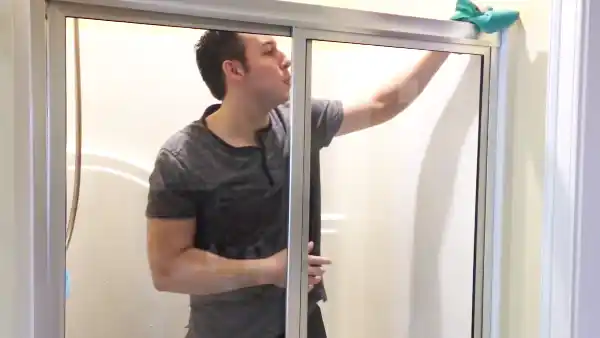
Use a Squeegee
Following these tips, you can use a squeegee to remove water and prevent streaks on treated glass shower doors.
A good squeegee is an essential tool for shower cleaning, as it helps remove water from the surfaces effectively and helps you avoid hard water stains, soap scum, and mineral buildup. Here are some tips:
- Start at the top: Hold the squeegee at the top of the door with the rubber blade pointing downward. This will prevent water from running behind the squeegee and making a mess.
- Use long strokes: Pull the squeegee down the door in long, steady strokes without stopping. This will prevent water from building up behind the squeegee and creating streaks.
- Wipe the blade: After each pass, wipe the blade with a paper towel to remove any water droplets or dirt. This will prevent streaking or smudging on the next pass.
- Angle the squeegee: Hold the squeegee at a slight angle so that the rubber blade makes contact with the door at a slight angle. This will help remove water more effectively and prevent streaking.
- Avoid pressure: Avoid applying too much pressure while using the squeegee. This can cause damage to the rubber blade and create streaks on the door.
- Re-wipe the corners and edges: Before finishing, go over the corners of the door with the squeegee, and then wipe them with a paper towel or microfiber cloth to remove any water droplets.
Scrub with a Sponge or Magic Eraser
Follow these steps to effectively scrub treated glass shower doors with a Magic Eraser or sponge, breaking up and removing dirt, grime, and soap scum. Scrubbing is essential in cleaning, especially when dealing with heavy buildup or stains.
Proper scrubbing can help to remove hard water stains, soap scum, or mildew and mold, making the door look new.
Use a Cleaning Solution or Paste

Apply a cleaning solution or paste to treated glass shower doors to break up and remove dirt effectively. Applying a cleaning solution or paste allows the product to work on the stains and dirt, dissolve them and make them easier to scrub off, making the cleaning process much more efficient.
Keep in mind that not all cleaning solutions are suitable for all surfaces or stains, so choose the right one and follow the manufacturer’s instructions. Here is a straightforward process to apply a paste or cleaning solution to treated glass shower doors:
- Choose the right cleaning solution: Choose the right cleaning solution for the type of stain you’re trying to remove, and follow the manufacturer’s instructions. Pay attention to the recommended usage, strength, and precautions.
- Apply the cleaning solution: If using a spray bottle, apply the cleaning solution directly to the shower door, making sure to cover the entire surface. If using a paste, apply it using a damp sponge or a scrub brush.
- Wait for the solution to work: Allow the cleaning solution to sit on the surface of the shower door for the recommended amount of time to help it break up and remove dirt and soap scum.
- Scrub the door: Using a scrub brush or sponge, gently scrub the shower door. Make sure to hold the brush or sponge at a slight angle to the surface to help agitate the grime. Scrub in circular motions for best results.
- Store the cleaning solution: Properly store the cleaning solution, following the manufacturer’s instructions, and dispose of any remaining solution following the proper procedures.
Maintenance and Prevention
Regular Cleaning Schedule
By creating and following a regular cleaning schedule, you can ensure that your treated glass shower doors are always looking their best. It takes time and effort to maintain the shower door, but following a regular schedule becomes a habit, and it will be much easier to keep it clean and clear.
Regularly cleaning the shower door, you can prevent the buildup of stains, soap scum, and mildew, which can be harder to remove once they set in. Take a look at a few tips for creating and following a cleaning schedule:

- Determine how often to clean: The frequency of cleaning will depend on factors such as how often you use your shower, the type of water in your area, and how well you maintain it.
For example, if you live in an area with hard water, you may need to clean more often to prevent mineral buildup than in an area with softer water.
- Set specific cleaning tasks: Determine what specific cleaning tasks need to be done, such as wiping down the doors, scrubbing away soap scum, or removing hard water stains.
- Assign specific days and times: Assign particular days and times of the week or month for the tasks. For example, you may wipe down the shower doors every Monday and scrub away soap scum every other Wednesday.
- Make a cleaning list: Create a list of all the cleaning tasks you need to complete, and check them off as you finish. This can help you stay organized and remember all essential tasks.
- Follow the schedule: Stick to the schedule you’ve created, and make sure to complete all the tasks on your list.
- Review and adjust as needed: Review your cleaning schedule regularly, and make adjustments as needed. If you find specific tasks aren’t necessary or the schedule is too demanding, make changes accordingly.
Use a Water Repellent or Sealant

Using a water repellent or sealant protects your treated glass shower doors from water damage and hard water buildup by making it hard for the water droplets to adhere to the surface and making it much easier to clean.
Choose the right product, follow the manufacturer’s instructions for use and maintenance to prolong the door’s life and keep it looking new. Here’s a step-by-step procedure to use a waterproofing or sealing product on treated glass shower doors:
- Clean the shower door: Make sure the shower door is clean and dry before applying the water repellent or sealant. Clean the door using a mild soap or cleaning solution, and rinse it thoroughly with warm water. Use a squeegee to remove any excess water.
- Apply the water repellent or sealant: Depending on the product, some sealant comes in spray form, and others in liquid or paste form. Apply the sealant or repellent to shower door surfaces to cover the entire surface.
Follow the manufacturer’s instructions for application. Usually, it’s recommended to use a clean cloth or sponge.
- Allow the product to dry: Allow the water repellent or sealant to dry completely, as per the manufacturer’s instructions.
- Re-apply as needed: Water repellents and sealants need to be reapplied regularly to maintain their effectiveness, usually, the recommended time is between 6 months to 1 year, but it depends on the product and on how often the shower is used.
Prevent Water Spots and Stains
Follow these tips to prevent water spots and stains from forming on treated glass shower doors, keeping them looking like new for longer.
Remember that prevention is the key, and by keeping the shower door clean, dry, and protected, you can reduce the frequency of cleaning and avoid hard-to-remove stains. Here are a few tips for preventing water spots and stains on treated glass shower doors:

- Use a squeegee: After every shower, use a squeegee to remove excess water from the shower doors. This will help to prevent water spots from forming.
- Dry the edges: Make sure to dry the edges and corners of the shower doors after every shower, as these areas are most susceptible to water spots and stains.
- Use a towel: Keep a towel near the shower and use it to dry off the shower doors after every use.
- Use sealant or water repellent: A water repellent or sealant can help to protect shower doors from water damage, stains, and hard water buildup.
- Keep the door clean: To remove any soap scum or any other dirt or grime from the shower doors, regularly clean and wipe down, as these can slowly lead to stains.
- Use a fan: Use a bathroom fan or open a window to help circulate air and prevent water from evaporating and leaving behind water spots.
- Avoid using abrasive cleaning products: Avoid using abrasive cleaning products or scouring pads, as they can damage the surface of the glass and lead to scratches and stains.
Are Scrubbing Bubbles Good for Treated Glass Shower Doors?
Scrubbing Bubbles are an excellent product for cleaning treated glass shower doors. This product removes soap scum deposits while leaving a streak-free finish.
The combination of surfactants, detergents, and enzymes produces a gentle deep clean on all treated glass surfaces. The aerosol packaging provides convenience, and the mild citrus scent adds a pleasant aroma to the shower area.
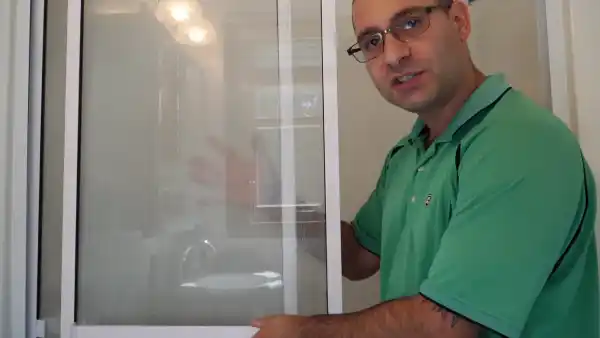
Does Dawn Powerwash Clean Treated Glass Shower Doors?
Dawn Powerwash is an effective cleaner for treated glass shower doors as it breaks down and dissolves tough dirt and grime while removing residue and streaks from the surface.
The formula combines powerful surfactants with water-soluble solvents to help lift away soils and grease quickly without causing damage to treated glass surfaces.
To use the product, simply spray directly onto the surface, and wait several minutes before wiping off with a damp cloth or sponge, followed by rinsing with warm water. Depending on the level of soil buildup, multiple applications may be necessary for optimal results.
How Do You Clean Texture Treated Glass Shower Doors?
Cleaning glass shower doors with texture can be challenging but possible. Start by spraying down the surface with a quality glass cleaner.
Allow it to sit for several minutes before using an old toothbrush or soft cloth to scrub away any residue or dirt buildup in texture areas of the door, as well as smooth surfaces such as frames and handles.
Once finished, rinse off any soap suds with warm water and dry with a lint-free cloth or paper towels.
Does Vinegar Clean Treated Glass Shower Doors?
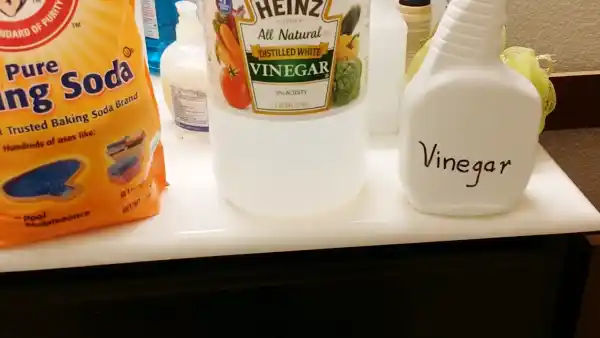
Yes, you can use vinegar to clean treated glass shower doors. Vinegar is a natural cleaner that is gentle yet effective at removing dirt and grime from surfaces. It has mild acidic properties that help dissolve hard water deposits from glass surfaces, making it a great option for bathroom cleaning.
For best results, start with a pre-soaked cloth in warm water and white vinegar solution, then use the cloth to wipe down the door’s surface. Cleaning the door will help remove any residue and buildup left by soaps or other cleaners.
After wiping down the door, use a squeegee to clear any remaining moisture and rinse with warm water. To ensure all the dirt to remove, add a few drops of dish soap to your solution, as it helps break up tougher residue.
Finally, dry with a clean microfiber towel or let air dry completely before using the shower again. With regular use, vinegar can help keep your treated glass shower doors looking new.
Final Thoughts
Treated glass shower doors can be a great asset in any bathroom. They look beautiful and help keep water out of your space. These unique shower doors require special care to keep them looking their best.
By learning about the importance of cleaning treated glass shower doors, along with which materials and techniques you should use, you can keep your grand entrance looking its best for decades.
With regular maintenance, such as wiping down after each use and treating with a repellent or sealant at least once a month, you can be sure that your treated glass shower door will remain attractive and functional over time.

